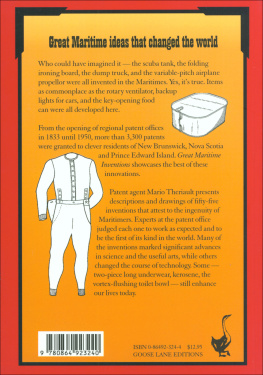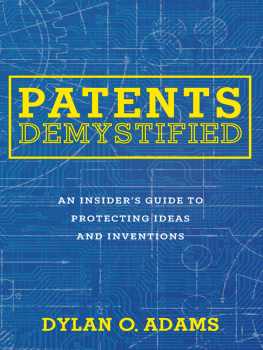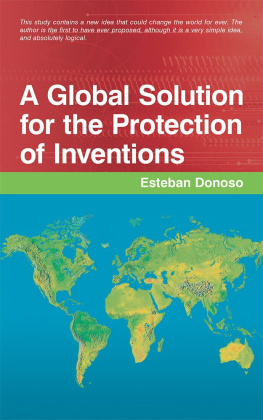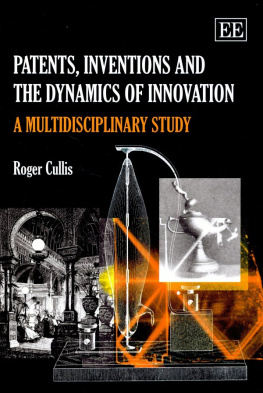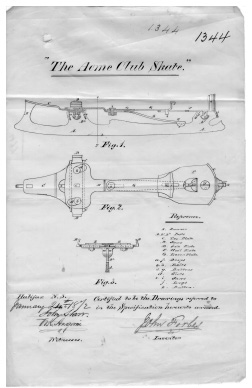GREAT MARITIME INVENTIONS
1833-1950
GREAT
MARITIME
INVENTIONS
1833-1950
Mario Theriault
Copyright Techniplans Inc., 2001.
All rights reserved. No part of this work may be reproduced or used in any form or by any means, electronic or mechanical, including photocopying, recording, or any retrieval system, without the prior written permission of the publisher. Any requests for photocopying of any part of this book should be directed in writing to the Canadian Copyright Licensing Agency.
Edited by Rhona Sawlor.
Book design by Julie Scriver.
Printed in Canada by Transcontinental Printing.
10 9 8 7 6 5 4 3 2 1
Canadian Cataloguing in Publication Data
Theriault, Mario, 1951
Great Maritime inventions, 1833-1950
Includes bibliographical references and index.
ISBN 0-86492-324-4
1. Inventions Maritime Provinces History.
2. Patents Maritime Provinces History.
I. Title.
T227.M37T48 2001 608.7715 C2001-901729-4
Published with the financial support of the Canada Council for the Arts, the Government of Canada through the Book Publishing Industry Development Program, and the New Brunswick Culture and Sports Secretariat.
Goose Lane Editions
Suite 330, 500 Beaverbrook Court
Fredericton, New Brunswick
CANADA E3B 5X4
www.gooselane.com
To all my client inventors, who have inspired me to write this book,
and most of all to my wife Norma,
whose support and encouragement made all things easy.
ACKNOWLEDGMENTS
A note of appreciation is extended to the Public Archives of Nova Scotia, to the Public Archives and Records Office of Prince Edward Island, to the Provincial Archives of New Brunswick, to the Canadian Intellectual Property Office in Hull, and to the United States Patent and Trademark Office in Washington, DC. A special thank you is extended to Carole Choinire of the Canadian Intellectual Property Office and to Palmer C. DeMeo of Palmer Patent Consultants in Woodbridge, Virginia, for their valuable assistance in identifying these memorable inventions and locating the related patent documents. Thank you again to Mr. DeMeo for having researched and explained the US patent law in force during the period covered by this book. Thank you to Rhona Sawlor for having elegantly edited this book. Thank you to Cheryl Hulberg for her assistance in typing the manuscript. Thank you also to Yoland Mallet of the Canadian Intellectual Property Office for having rejuvenated a copy of the Canadian patent for the Acme Club Skate.
CONTENTS
The patent for the Acme Club Skate, granted to John Forbes of Halifax, Nova Scotia, on February 17, 1872. Courtesy of the Canadian Intellectual Property Office.
INTRODUCTION
Letters Patent are granted to applicants for bringing into use new trades or new manufactures, for presenting new knowledge to the public, and for promoting the progress of science and useful arts. During the period covered by Great Maritime Inventions, 1833-1950, the two basic requirements for a patented invention were utility and novelty. (Inventiveness is a third requirement under modern patent law.) Concerning the element of utility, the invention had to be useful, to work as expected, and to produce the promised results. A model of the invention was often required to demonstrate utility. To meet the requirement of novelty, the invention must not have been known or used by others, in the province or in any other country, prior to its discovery.
Before Confederation, each province had its own patent system, modelled on the systems used in the United States and Great Britain. The following extract from the Revised Statutes of Nova Scotia, Chapter 120, entitled Of Patents for Useful Inventions, dated 1833, outlines that provinces first patent system:
Whenever any person resident in the Province, and who shall have resided therein for the period of one year, or any British subject who shall have been an inhabitant of Canada, New Brunswick, Prince Edwards Island, or Newfoundland, for the space of one year previous to his application, shall apply to the Governor, alleging that he has discovered any new and useful art, machine, manufacture, or composition of matter, or any new and useful improvement thereon, not heretofore known or used, and pray that a patent may be granted to him for the same, the Governor may direct Letters Patent to be issued, reciting therein the allegations of such petition, and giving a short description of such invention, and shall thereupon grant to the person so applying for the same and his representatives, for a term not exceeding fourteen years, the exclusive right of making, using, and vending the same to others, which Letters Patent shall be good and available to the grantee, and shall be recorded in the Secretarys Office, in a book for that purpose, and shall then be delivered to the patentee.
The 1833 statutes also stipulated: Before any person shall obtain any Letters Patent, he shall make oath in writing that he verily believes that he is the true inventor or discoverer of the art, machine, or composition of matter, or improvement, for which he solicits Letters Patent, and that such invention or discovery has not been known in this province or any other country, which oath shall be delivered in with the petition for such Letters Patent.
A similar patent system was established in New Brunswick in 1834 and in Prince Edward Island in 1837. The patent systems of all three provinces were transferred to what is now the Canadian Intellectual Property Office in Hull shortly after Confederation, between 1869 and 1874.
The novelty or originality of the inventions described in Great Maritime Inventions is reasonably dependable. Each patent is either the first of its kind on record or the claims in it are so broad that the intellectual property protection afforded by the patent encompasses every possible precursor. The uniqueness of each invention is accepted based on the applicants signed declaration of absolute novelty and on the knowledge and literature available to the examiners at the patent office at the time of the application.
Although great care has been taken to ensure that each invention is in fact a pioneer, it may be possible using modern information technologies to demonstrate that this or that invention was perhaps not quite the first of its kind in the world. On the other hand, it may also be possible to demonstrate that each alleged prior inventor had kept his invention as a trade secret, had disclosed it only to a select few under a confidentiality agreement, or simply did not file a patent application for it. Earlier inventions that are outside the patent system were also outside the scope of this book.
Under patent law, a patent is granted to an inventor who is willing to share his knowledge with the public. Each patent listed here went through a thorough examination by experts at the patent office. On the invention date, each invention was found to present new knowledge to the public and was seen as an important step forward in the evolution of science and the useful arts. Therefore, I considered the integrity of the patent office sufficient to support my claims of novelty.
Not all inventions are spectacular. In fact, most of the inventions described in
Next page
